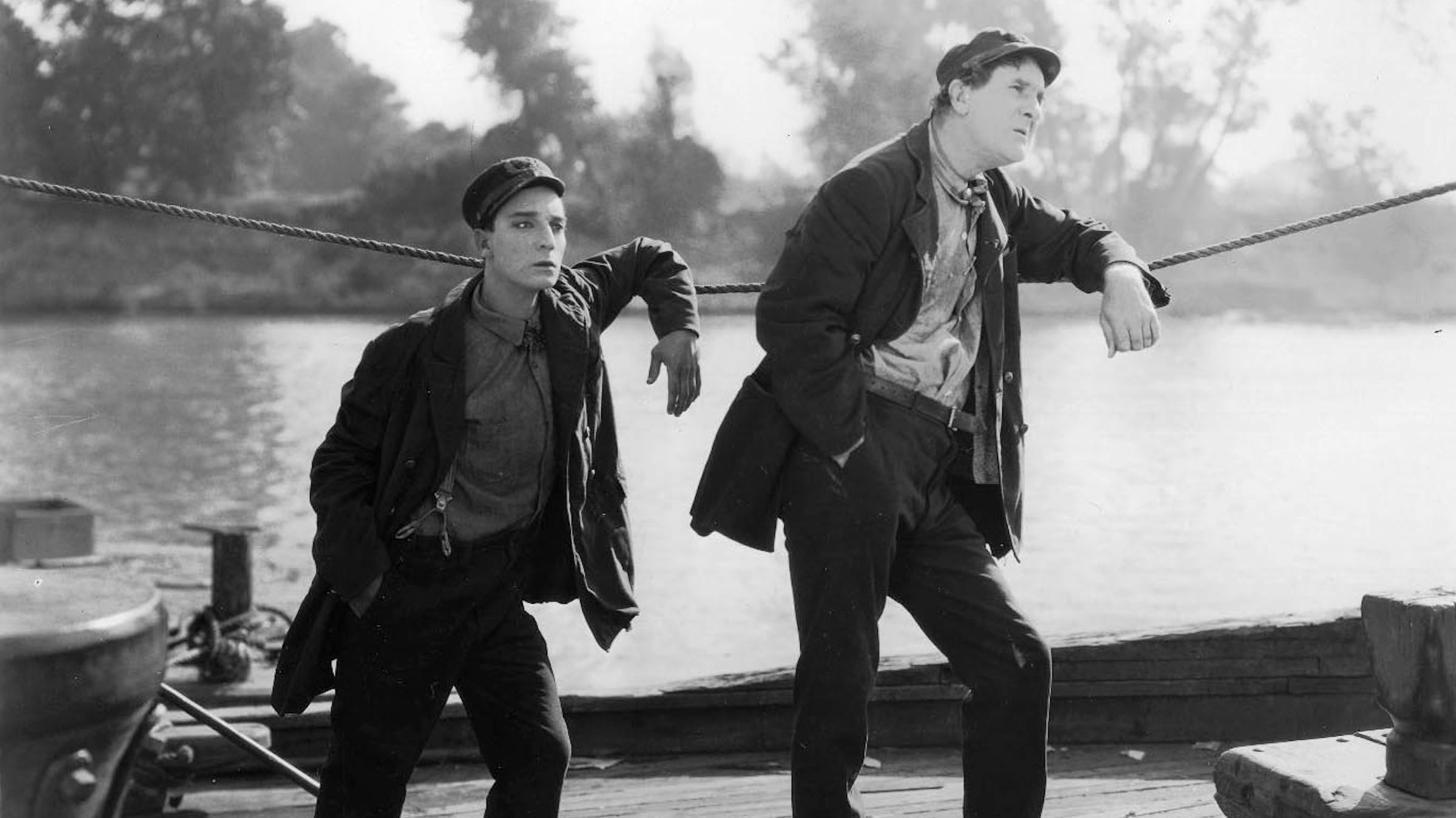It’s appropriate that the elaborate set piece of Steamboat Bill, Jr. is a cyclone. Legend has it that when Joseph Francis “Buster” Keaton was born in Piqua, Kansas, on October 4, 1895, there was a gigantic windstorm.
And when he was just 20 months old, he was supposedly sucked out of an open dressing-room window by an actual cyclone, which deposited him unharmed some four blocks away. These incidents not only presaged Keaton’s tumultuous career, but they also served as fodder for his comedic imagination, to be used and re-used in many of his films.
Buster Keaton was born into a theatrical family. His parents, Joe and Myra, had a traveling medicine show, and Buster joined the act as soon as he knew how to crawl. The Three Keatons became a vaudeville sensation, touring the United States and England from 1897 to 1917.
A popular part of the act involved Joe throwing Buster around the stage, into the wings, and even at the audience on occasion. Buster became known as “The Human Mop” and “The Child That Cannot Be Damaged” because he was able to take falls with comedic, acrobatic skill and without serious injury. His name, in fact, derived from the observation of a fellow performer who, witnessing Buster do a fall down a flight of stairs, declared the kid “a buster.” Buster attributed his famous frozen face to the early years of being batted about, claiming he knew at a very young age that he got bigger laughs if he didn’t smile.
When Joe finally broke up the act in 1917, Buster continued his stage career as a solo performer in The Passing Show of 1917 on Broadway. A chance meeting—and his own natural curiosity about the mechanics of filmmaking—propelled him into the world of cinematic comedy.
Invited to visit the Talmadge Studios on East 48th Street in Manhattan, he was asked to join the cast of The Butcher Boy (1917), in which he played a supporting role to the very popular Roscoe “Fatty” Arbuckle. Arbuckle would become Buster’s teacher, mentor, and friend. “Everything I know about making movies I learned from Roscoe,” Keaton always said.
Enraptured by filmmaking, he made 15 two-reelers with Arbuckle’s Comique Film Corporation over the next three years. In 1920, Arbuckle signed a lucrative contract with Paramount Pictures, and the Comique Film Corporation was turned into the Keaton Studios.
Steamboat Bill, Jr. (1928) was the last film Keaton made over which he had writing and directorial control. Set on the banks of the Mississippi (and filmed on the Sacramento River), the climactic set piece was originally conceived as a flood, and construction for the sequence was nearing completion when a devastating flood of the real Mississippi caused the studio to cancel Keaton’s plan. Forced to go over schedule and over budget, Keaton proposed a cyclone, and he began preparing for the new scenes. He brought in airplane engines to simulate the cyclone effect and constructed breakaway buildings that could fly apart or collapse when needed.
The cyclone has its roots in Keaton’s past, and there are many such autobiographical references in the film. In the sequence where Buster is caught in an abandoned theater during the cyclone, he shows us several artifacts of his vaudeville days: the magician’s disappearing cabinet, the secret to which Buster reveals in the film, and the frightening ventriloquist’s dummy, which refers to an incident from Buster’s childhood when he was trapped in a suitcase with just such a doll for several hours.
One of the most iconic images in Steamboat Bill, Jr. involves a breakaway building that was carefully constructed to collapse around Keaton without harming him. By strategically positioning himself beneath a second-story window, he was able to create a death-defying visual gag that still invokes awe. Had his calculations been off by even two inches he would have been driven into the ground like a tent peg.
There has been much speculation about why Buster attempted such a potentially suicidal stunt. During the production of Steamboat Bill, Jr. Keaton learned that his production company was being disbanded and his services were being sold to MGM, where he would no longer have creative control. In addition, his wife was divorcing him and changed the names of his children so they would no longer bear his name. He himself was quoted as saying he was angry and didn’t much care what happened to him.
This amazing sight gag continues to inspire filmmakers and artists to this day. Jackie Chan paid homage to Buster Keaton by restaging the stunt in his 1987 action farce Project A, Part II, and, in 1997, the British artist Steve McQueen recreated it in his video piece Deadpan, for which he won the prestigious Turner Prize.
Buster Keaton made many more films, but he was rarely given the opportunity to create the breathtaking comedy that he produced in the ’20s. He died in 1966 at the age of 71.
Presented at SFSFF 2000 with live music by Alloy Orchestra

